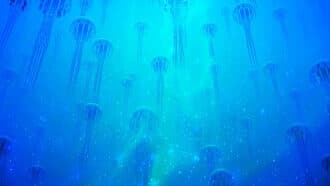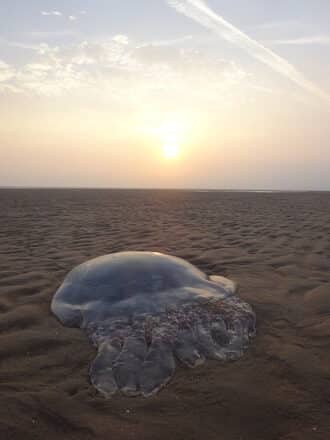By Lisa Cohen
Looking back at this year’s summer vacation, remembering the days that we excitedly packed up our sandwiches, towels, bucket and spade ready for a fun day out at the beach with the family…… but, later came home with crying children who had been bitten by Mediterranean jellyfish, we want to know why! Not knowing whether we are swimming by a plastic bag or a jellyfish species is confusing and painful either way! But, this is the new reality for families in Israel, Lebanon, Turkey and Greece: pollution and many jellyfish in the eastern Mediterranean Sea.
Mediterranean Jellyfish
There is an alarming annual increase in the jellyfish population. It has been found that this increase includes native species but increasingly invasive species, not native to the Mediterranean Sea.
More than 500 new species have entered the region through the Suez Canal. The most common jellyfish is the Nomad Jellyfish, rhopilema nomadica, which today makes up over 90% of the population in the Mediterranean. It arrived as part of the largest invasion of marine life ever to occur on the planet – the Lessepsian migration – from the tropical waters of the Indo Pacific Ocean through the Suez canal to the Mediterranean.
Native & Invasive Jellyfish In The Mediterranean
The Cotylorhiza tuberculata is the Mediterranean’s commonly found native jellyfish, of the Phylum Cnidaria family, is also known as the fried egg jellyfish. The moon jellyfish can be found in the whole Mediterranean sea and the Black sea.
Non indigenous jellyfish arrive in many ways. The previously mentioned rhopilema nomadica jellyfish was first sighted in 1976 but large populations of them were witnessed from 1980 onwards.
Australian Spotted Jellyfish and the Purple Jellyfish originated from the Pacific ocean. They presumably arrived to the Mediterranean as small polyps, small jellyfish or tiny jellyfish attached to boats or they slowly drift through the Red Sea as eggs, larvae or adults.
New jellyfish in the area include the Comb Jellyfish which is also an invasive species and was first noticed in 2009. As long as the Suez Canal is open, obviously invasive species will continue their migration to the temperate waters of the eastern Mediterranean sea.
The Decline in Jellyfish Predators
However, another reason for the increase in the jellyfish blooms we see today is the decline of jellyfish predators in the marine ecosystem. The global systematic removal of predator-like fishes such as tunas and cods and overfishing of fishes in pond waters can cause a devastating impact. In marine ecosystems species’ biodiversity are eventually replaced by primitive species like jellyfish.
For example, the collapse of a small fish species near the surface, like sardine or anchovies reduces the pressure to eat jellyfish and increases their nutritional value. The change to the ecosystem is then amplified when jellyfish outcompete them to attack the same zooplankton species. Consequently, the increase in jellyfish populations may appear beneficial to critically endangered species like the leatherback turtle.
Turtles however are among the only few predators for bigger jellyfish but are themselves at risk from overfishing and therefore negate their potential impact on jellyfish numbers. If you want to see a decline in jellyfish numbers, start by saving turtles!
The Correlation Between Increased Pollution and Jellyfish Numbers
Sewage and agricultural nutrients that run from land into the sea increase the nutrients in the sea. As a result, there is an increase of plankton in the oceans for the jellyfish to feed on. Additionally, the life cycle of jellyfish is encouraged by low levels of oxygen so that the sewage is beneficial in every way to them, resulting in exploding population numbers.
Climate Change Helping Jellyfish Populations
As climate change heats up the world’s oceans many marine ecosystems are not surviving, including coral reefs and mangroves. But at the same time jellyfish are thriving due to the new environmental conditions created by climate change as the Mediterranean jelly, the adult medusa multiplies rapidly in warmer, less oxygenated and more acidic waters.
The Impacts Of An Increase In Jellyfish
“Jellyfish directly interfere with many human activities specifically, through stings (beach closures, tourism impacts, injuries, deaths), clogging intakes (coastal power and desalination plants, mining and military operations, shipping, aquaria), interference with fishing (clogged and split nets, spoiled catch, stung fishers, damaged gear, capsized boats), aquaculture (fish deaths, pens fouled by polyps), and marine biological surveys (interference with trawls and acoustic surveys).”
Jelly fish are affecting life saving desalinization projects by blocking the pipes. Tourism is obviously one of the most harmed industries, especially as summer swarms of jellyfish range from May to August, the beach going season, peaking in July – for the school summer holidays.
Jellyfish Change Marine Ecosystems
The marine ecosystem is adversely affected by the increase in Jellyfish populations. By feeding on eggs, larvae, gelatinous zooplankton and young fish the jellyfish are affecting fishery resources. The fish also need to compete with the jellyfish for the same food with the jellyfish winning.
When A Jellyfish Bites You!
Winter Jellyfish swarms include the Mauve Stinger, swept from the western Mediterranean in winter storms. They are venomous but most people in the sea in winter are surfers who are protected from the sting by their wetsuits.
To help protect summer swimmers from a jellyfish sting, Israeli scientists developed a jellyfish tracking app for beachgoers so that everyone can see where there are jellyfish outbreaks. Then, you can choose whether to enter the sea, put on a protective wet suit or use anti jellyfish sunscreen.
If you do get a sting you first need to remove any visible tentacles with tweezers and then soak the affected area in warm water. It helps to reduce the pH level by pouring vinegar on the sting to reduce the pain and inflammation, but do not rub the affected area which causes the venom to spread. For accurate information, look at the Ministry of Health’s website.
Jellyfish and Religion
Here’s a fun connection: Three weeks a year, religious Jews avoid certain activities, like swimming, as a way to mourn the destruction of the Jewish Holy Temple, 2000 years ago. And during that same “Three Week” time period, there is often a swarm of jellyfish off the coast of Israel that makes swimming in the ocean a dangerous activity.
Mystical synchronicity? Random coincidence? Who knows?
Whatever the reason for the overlap between the Jewish custom of not swimming during the “Three Weeks” and the jellyfish that plague the beaches, one can derive an important lesson: there’s something special about indigenous traditions. Whether by chance or design, indigenous traditions are often correlated with local natural events. We can learn from the indigenous traditions in our area how to live in harmony with our natural surroundings. Or ignore these traditions until we get stung.
* Featured image source









I would like to know which species of jellyfish in the Mediterranean are edible?
Here’s an interesting article: https://ec.europa.eu/research-and-innovation/en/projects/success-stories/all/jellyfish-out-ocean-and-menu.